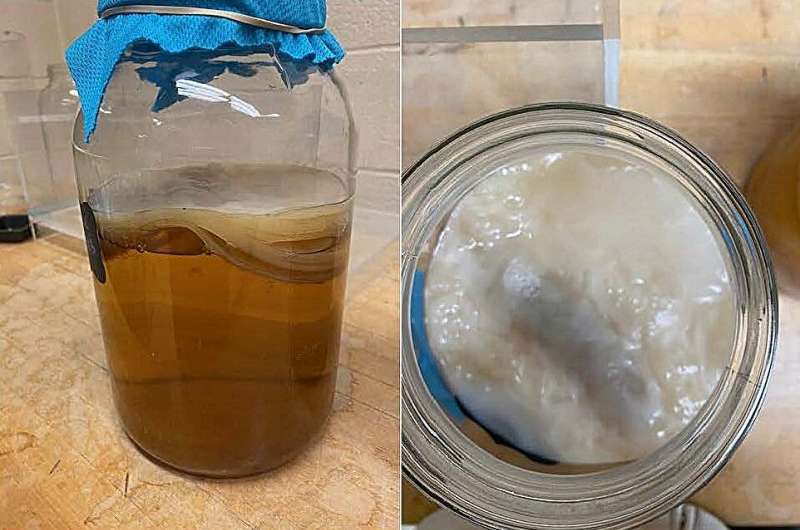
In a glass jar, a kombucha pellicle—the rubbery puck of cellulose that holds most of the bacteria and yeast culture—forms at the surface (top). With the silicone bags, however, the researchers noticed that the pellicle formed all the way around the inside (bottom). The increased surface area of the culture in the silicone bag may be one of the factors that speeds fermentation compared to traditional jars. Credit: Jeb Kegerreis
Kombucha is a fermented tea known for its health benefits and tangy kick. But brewers can find it challenging to keep kombucha’s alcohol levels low because the bacteria and yeast used in the fermentation process vary from batch to batch.
Now, chemists from Shippensburg University are investigating ways to reliably minimize alcohol, tailor taste profiles and speed up the kombucha fermentation process to help home and commercial producers optimize their funky brews.
The researchers will present their results today at the spring meeting of the American Chemical Society (ACS Spring 2024).
Kombucha brewing typically begins with a glass jar filled with tea, water, sucrose and a fermentation starter called a SCOBY—short for a symbiotic culture of bacteria and yeast. The yeast breaks down the sucrose, producing ethanol; simple sugars, glucose and fructose; and carbon dioxide. The bacteria then convert most of the ethanol and the remaining simple sugars into acetic, gluconic and lactic acids, which contribute to the flavor profile of the brew.
But SCOBYs are alive and can be unpredictable. So, when the bacteria aren’t getting rid of the ethanol or developing the right acids for the flavor profile, the kombucha brewer may need a chemist to help them save future batches from the same fate.
“Brewers typically see making kombucha as an art more than a science,” says Jeb Kegerreis, a physical chemist and one of the team’s principal investigators. “So, when we are doing a consultation, we also walk the brewer through the biochemistry of what’s happening during fermentation.”
Credit: American Chemical Society
Kegerreis works with fellow analytical chemist and principal investigator John Richardson, who formed a consulting company within the university called Cultured Analysis to help kombucha producers and to discover new ways to optimize the brewing process. Together with undergraduate chemistry students, they’ve gained interesting insights into using alternative containers and SCOBY food sources for reliably brewing non-alcoholic and better-tasting kombucha.
Investigating the use of silicone bags as an alternative to glass jars for brewing kombucha came about when a fellow brewer shared with Richardson that the silicone sous vide bags they were using fermented the tea faster and created more acid compared to glass jars. The brewer understood the quick production of acids likely meant the bacteria were getting rid of ethanol faster, but they wanted the scientists’ help to figure out why.
The team found that a silicone bag’s porosity, compared to a nonporous jar, exposes the SCOBY to more oxygen, which speeds up the brewing process—including ethanol breakdown and acid production—and cuts production time from about two weeks to one week. But they were surprised to see inconsistent levels of dissolved oxygen in the silicone bags compared to the glass jars.
“Next semester, we will investigate what else contributes to the silicone bag being a better brewing vessel,” says Emily Swartz, one of the team’s chemistry students.
According to Richardson’s kombucha-tasting expertise, tea brewed in a silicone bag is just as delicious as tea brewed in a glass jar.
Speaking of taste, the researchers noticed that they were getting more gluconic acid with silicone bag brewing compared to jars. “We think this acid will become more popular with brewers,” says Kegerreis. “Gluconic acid provides acidity without the sour vinegar taste you get from acetic acid, and that may appeal to more tastebuds.”
Because gluconic acid is a product of bacteria fermenting glucose, the researchers investigated how starting with glucose or fructose instead of sucrose changes the kombucha fermentation process and taste. “During the fermentation process, yeast in the SCOBY breaks sucrose into glucose and fructose,” says chemistry undergraduate student Abbi Czarnecki. “By using just glucose or just fructose, we looked at how removing that first step affects the whole brewing process.”
The team found that using glucose as the SCOBY food source created a kombucha with more gluconic acid and minimal ethanol. With fructose, the researchers measured more acetic acid and more ethanol. “If minimizing ethanol production is the measure of our success,” says Ian Loscher, a chemistry undergraduate and one of the team’s poster presenters, “fructose failed in that department. Out of all three sugars, it produced the most ethanol.”
Richardson says the fructose brews tasted sweeter. “I prefer a less sweet kombucha, but it’s not necessarily bad,” he admits.
What’s important to the team is sharing what they have discovered about different sugars and fermentation vessels because that information can help brewers create a kombucha that hits all the flavor notes and characteristics they want to aim for.
“Brewing kombucha can still be a very creative process,” says Richardson. “But when something goes wrong during fermentation, science can help make it right.”
Citation:
Better kombucha brewing through chemistry (2024, March 17)
retrieved 17 March 2024
from https://phys.org/news/2024-03-kombucha-brewing-chemistry.html
This document is subject to copyright. Apart from any fair dealing for the purpose of private study or research, no
part may be reproduced without the written permission. The content is provided for information purposes only.
>>> Read full article>>>
Copyright for syndicated content belongs to the linked Source : Phys.org – https://phys.org/news/2024-03-kombucha-brewing-chemistry.html






























